ShodhKosh: Journal of Visual and Performing ArtsISSN (Online): 2582-7472
|
|
FASHION ACCOUTREMENTS: VERSATILITY FOR MULTI-UTILITY CLOTHING -“A FANTASY WARDROBE CONCEPT”
Leela Mantri 1![]()
![]() ,
Dr. Smriti Agarwal 2
,
Dr. Smriti Agarwal 2![]()
![]()
1 PhD
Scholar, School of Design, Mody University of Science and Technology, Lakshmangarh, Sikar-332311, Rajasthan, India
2 Professor,
School of Design, Mody University of Science and Technology, Laxamangarh, Siker-332311, Rajasthan, India
|
|
ABSTRACT |
||
|
Today's young fashion consumers are seeking unique silhouettes to craft more appealing and aesthetic looks. The strong desire for individuality necessitates the exploration and utilization of basic silhouettes. Silhouettes serve as the core structure of the design, providing an authentic foundation upon which innovative solutions can be built. This study focuses on the redesign of additional articles of clothing for their multi-functional utility. Fashion accompaniments allow for the seamless integration of existing wardrobe pieces, significantly curbing excessive clothing consumption and waste, thus promoting sustainability. These versatile clothing pieces offer a range of styles, discouraging the need for frequent clothing purchases. This integrated approach can curb the impulsive buying habits among young fashion consumers presenting a creative solution for fashionable looks. The key is to familiarize customers with strategically planned wardrobes that include compatible detachable clothing pieces. Fashion accompaniments can be augmented to mix and match with existing wardrobe clothing pieces. Designers and fashion brands can be encouraged to focus on perennial clothing with a contemporary touch. It is crucial to educate consumers on the versatility of these accompaniments to effectively incorporate them into daily life. This study seeks to repurpose remnants from high fashion silhouettes into detachable pieces that can be transformed into new clothing designs. The adoption of simplified patternmaking concepts can minimize procurement costs. These silhouette overlays have the potential to revolutionize design and style experimentation, and traditional design boundaries. The transformation of basic shapes into versatile forms can unlock limitless possibilities for their optimal use, leading to an eco-friendly approach to fashion. The suitability of the silhouette to the figure type is a crucial factor in the selection process. The study proposed the implementation of CLO3D technology by brands to personalize looks and ascertain suitability to figure type for captivating results. |
|||
|
Received 11 May 2024 Accepted 23 July 2024 Published 31 July 2024 Corresponding Author Leela
Mantri, leelamantri21.sod@modyuniversity.ac.in
DOI 10.29121/shodhkosh.v5.i2.2024.1243 Funding: This research
received no specific grant from any funding agency in the public, commercial,
or not-for-profit sectors. Copyright: © 2024 The
Author(s). This work is licensed under a Creative Commons
Attribution 4.0 International License. With the
license CC-BY, authors retain the copyright, allowing anyone to download,
reuse, re-print, modify, distribute, and/or copy their contribution. The work
must be properly attributed to its author.
|
|||
|
Keywords: Strategic Wardrobes, Fashion Accompaniments,
Versatility, Transformation, Multi-Utility Clothing |
|||
1. INTRODUCTION
The review article aims to explore the concept of fashion
accompaniments to enhance the adaptability and multi-utility of clothing. The
core of the study is the redesign of clothing that serves to be used in
multiple ways, interchangeable for multiple purposes by different people,
thereby reducing excessive consumption and waste in the fashion industry. The
proposal is to integrate detachable pieces that can be mixed and matched with
existing wardrobe items, fostering a sustainable approach to fashion. Quillan
(2020)
The study analyses silhouettes as the fundamental
structure of design, with the potential for innovation and uniqueness. The
silhouettes are categorized based on the fit as sheath, semi-fitted, and loose
or flared and accentuated their suitability for different figure types and
occasions. The study proposed that close-fitted and flared styles are quite
popular due to their versatility and semi-fitted silhouettes are preferred more
on the grounds of comfort and suitability.
The research emphasizes the importance of sustainable
fashion practices, such as repurposing leftover materials from high-fashion
garments into detachable pieces. This not only minimizes cost but also promotes
eco-friendly wardrobes. The authors advocate for simplified pattern-making
concepts and the use of virtual try-on technology to personalize looks and
ensure suitability to figure types.
The methodology part is focused on the experimental
process of creating adaptable clothing from skirts, showcasing the
transformation of basic garments into versatile pieces. The study reveals that
a single piece of clothing can be styled in multiple ways, catering to various
occasions and consumer preferences.
The study concludes that fashion brands can play a pivotal
role in promoting sustainable fashion by offering innovative products that meet
consumer demands without compromising on style or functionality. The study
encourages the use of leftover fabrics and the creation of multi-faceted
garments that can be worn in various ways, reducing the need for frequent
purchases and contributing to a sustainable economy.
1.1. Silhouettes Study & Survey: Analysis of Fit and Consumer Preferences
Detailed study of silhouettes, their analysis, and
suitability to figure type lays a strong foundation for their selection and
their incorporation with detachable pieces to create various styles with
limited pieces of clothing. It is essential to get into the insights of the
concept to nurture the consumers to select them and attain various fashionable
looks as per their needs and suitability. The study incorporates broadly three
types of silhouettes which are segmented based on fit as sheath, semi-fitted, and
loose or flared. Each silhouette type caters to different figure types and
consumer preferences.
Figure 1

|
Figure 1 Clothing Guide- Types of Dresses. Www.Stylebox.ca.https://i.pinimg.com/originals/32/26/bb/3226bbf51cb4c5d96d908733a5ab5e41.jpg |
Dress Silhouettes from the origin were based on geometric forms. They are the core structures of designing and the golden rule of the design process is to first decide on the silhouette and other design elements to be appended thereafter. Islam Kiron (2021)
Basic silhouettes are classic pieces and can lay a strong foundation for innovation in clothing.
Figure 1 & Figure 2 represents rectangular, straight columns, triangular, wedge-shaped, and tent-shaped silhouettes. G (2022) These silhouettes are quite classy and can be accustomed to different categories of wear. They could be further accentuated with design elements, stylelines, volume, and decorative details. Style, fit, and comfort are the most essential attributes for the adaptation of clothing.
Figure 2

|
Figure 2 Clothing Guide-Types
of Dresses. Www.Stylebox.ca.https://i.pinimg.com/originals/32/26/bb/3226bbf51cb4c5d96d908733a5ab5e41.jpg |
Fit and its analysis in dress silhouettes is a vital phenomenon for design considerations. Dress
Silhouettes on the grounds of fit are majorly classified as follows [As featured in Figure 1 & Figure 2]
Figure 3

|
Figure 3 Silhouette Styles Self-Evaluation Based on Fit. |
1) Sheath
Styles:
Sheath silhouettes are form-fitted and suitable to ideal
figure types. Prime examples of this style are corsets, bustier tops, fitted
jeans, pencil skirts, and mermaid dresses. These silhouettes are featured as
closely fitted to the body through darts, tucks, and princess-style lines along
with slits and zippers for easy mobility. These silhouettes are progressively
worked with fabrics like jerseys, lycra, and other
stretchable fabrics. Heavy to medium-heavy woven fabrics are used for these
structured silhouettes. These silhouettes stand ideal for gym wear, sportswear,
and evening formal parties. Silhouettes are priced high comparatively
concerning the fit involved in it. Pattern making of these silhouettes needs
the expertise to retain the fit of clothes. Body-fitted silhouettes are ideal
for hourglass figures which emphasize the bodylines of the wearer.
2) Shift
or Semi-Fitted Styles:
Semi-fitted styles are silhouettes with little ease, easy-going, and comfortable for all age groups and figure types. Rectangular or straight column and A-line silhouettes are ideal for semi-fitted styles. Design and decorative details of choice can be featured in this category. Day-to-day casual wear to semi-formal wear clothes are included in these styles. They are pocket-friendly, comfortable to wear for a long duration, and aesthetically ideal for the majority of the figure types. Fabrics of lightweight to medium-weight can be chosen according to the suitability of the wearer. These silhouettes are mass-produced & consumed within a price range and the potential of the wearer.
3) Loose
or Flared Styles:
Fit and flare or loose silhouettes have a bifurcation concept. They are referred to as flared styles with fit at the upper bodice and another one as loose style for resort or holiday wear. Fit and flare is a dual phenomenon found in evening wear silhouettes. These styles are suitable for the majority of the figure types and look glamorous on special occasions. Fabrics of light to medium weight, flowy, with a sheen look, are ideal for producing voluminous garments. Excess fabric consumption is involved in these styles. Design and decorative details are implemented in abundance and a lot of layering is found in these styles.
Examples of flared styles are tent dresses, capes, layered, tiered, and circular dresses. Price lines are usually high for high fashion wear. These silhouettes can be reclassified as tops, skirts, pants, jackets, overgarments, and dresses.
Silhouette separates could be mixed-matched to develop various sets of outfits. Combinations can be worked as per the suitability of the figure type and consumer’s requisite for the category of wear.
Table 1
|
Table 1 Interpretation of Data Collected from the Female Age Group of 18-35 Years in Hyderabad (Telangana) Through a General Observation and Informal Group Discussion. |
|||
|
S. No. |
Category |
Demand & observation Utility |
Respondent comments |
|
1 |
Close-fitted
clothes |
30% |
Not
comfortable for day-to-day clothing, Expensive, preferred by few |
|
2 |
Semi-fitted
silhouettes |
90% |
Most
preferred, comfortable, Easy going for all occasions |
|
3 |
Flared
silhouettes a.
Fit & Flare b.
Loose clothes |
60%-demand
& utility-20% 60%-demand
& Utility-60% |
Highly-priced, preferred for special
occasions Holiday
or leisure wear |
|
Analysis Result Fit and flared styles are more in demand but
have less utility. |
|||
Table 1 Exemplifies the
usability of clothing and the respondent's view of the same. Fit and flared
clothing is personified as a means of excess consumption, less utility, and
more textile wastage.
Figure 4

|
Figure 4 Analysis of Silhouettes |
Figure 4a, 4b, and 4c represent
statistical analysis of the data collection done to evaluate the demand,
utility, and relative analysis of demand and utility. Analysis was the
usability of semi-fitted silhouettes following demand and utility. Fitted
silhouettes were suitable to limited figure types and were preferred mostly by
youngsters for parties and working professionals for formal occasions.
Flared silhouettes were glamorous with less utility and high production cost. These flared silhouettes can be replaced with detachable overlays for additional look and enhancement. They could be paired comfortably with fitted and semi-fitted trendy silhouettes. Fitted and semi-fitted clothes could be paired with detachable or additional adaptable clothes which could be worn in different ways to present as per the new trend. Adaptable clothing with a simple pattern-making process can create different styles. High fashion garments utility is found to be less and can be a prime aspect for the adaptability of sustainable fashion.
1.2. Transformable Fashion & Sustainability- Scope and Acceptability
The literature review exemplifies the transformation,
modular fashion, recycling, and upcycling concepts. Its incorporation is found
to be minimal in real applications. Initially, the
transformational fashion included the usage of electronics in Chalayan’s
collection, chemical inks were used to change the clothing items coloring was bought into pictures as hyper colour t-shirts.
They looked like more art pieces rather than clothing. It limited
the use for consumers due to the difficulties involved in its usage and lack of
flexibility. It requires additional & expensive equipment for its
production with intricacy in it. Consumers found it challenging to wear
transformable clothes as most of them are unconventional and have limited
acceptance.
The concept of changeable pieces of clothing can be applied to various dress silhouettes which are transformed as fashion accompaniments to enhance the look of an outfit. Adjustable design components and modular clothing can be incorporated in the most conventional form as a problem solver for the growing demands of the industry. Multi-utility is the prominent feature concerning the styles, seasons, and occasions. A single piece of clothing can be multi-faceted featuring durable and changeable flexibility. Transformational fashion was modified for adjustable clothing that is fastened with zippers, hooks & eyes drawstrings, and detachable components that can be eliminated or added to the clothing. A lot of similarity is found in transformational & modular clothing. Modular clothing was pictured with the concept of detachable pieces to suit the changing needs of the time. Changing of lengths was not supported by all and production costs were considered very high in these items of clothing. Zhang et al. (2024)
The study emphasized the practical
implementation of detachable clothing into wardrobes by both designers and
consumers to embrace this concept. The concept was sighted in the mid-17th
century with the use of detachable collars, cuffs, convertible sleeves, interchangeable
panels, and pockets was introduced to simplify garment care and for easy
fashion changes. The aim was to create a variety of styles. keeping wardrobe
dynamic and versatile, giving a fresh look for different occasions. Hasan
(2021)
Transformable garments can increase wear frequency,
delay disposal, and ultimately extend the garment's lifespan, as consumers
continually adapt them. Although transformable garment design offers the
potential for making fashion more sustainable, there is a lack of understanding
regarding the importance consumers place on variety in their clothing and the
design features needed for garments to be effectively adaptable or dynamic. Versatility is considered as most essential while
preferring changeable design functions. These are opted by consumers on
the grounds of functionality, ease of matching, layering, comfort, and fun to experiment
with various styles in terms of modesty. Koo et al. (2013)
1.3. Review on Consumer Buying Behaviour
The study states that consumer
buying behavior for branded garments gained more
prominence among youngsters and was constituted majorly by female students. The
study was designed to focus on branded apparel as apparel and textile
industries were major contributors to the growth of the economy. Rajput & Khanna (2014). Fashion brands have to inculcate
sustainable concepts and offer innovative products to consumers in lieu of
consumers' interests needs and preferences.
The study discussed fashion
innovators as frequent buyers spending more money on new products and
product-evaluative clothes. They targeted the young age group of under 30 as
the ideal consumers as they seek not only functional benefits but even the aesthetic
and experimental values of a product. They are technologically strong and
receive new ideas in execution. Rehman
& Kharb (2018)
The study directed the concept
of detachment toward the desire for new clothing and emotional attachment to
the existing pieces of clothing in the wardrobe. Mellander & McIntyre (2021). This detachment from fashion practices might not be
preferred by young minds for the emotional significance of clothes. Novelty is
prioritized by today’s generation. Problem solver has to
cater to the needs of the fashionistas with a sustainable approach to fashion.
It states that
the design education process plays a major role in the fashion industry’s
apprehension of sustainability, looking at the concept of how to make designing
more sustainable. Azman et al. (2019)
Sustainability
to be more effective has to be directed with certain
principles and practices in designing. It focuses on philosophies about
material sourcing, fabric treatment, production methods, conserving resources,
social impact, transparency, and encouraging attachment and appreciation. Aakko & Sivonen (2013)
Adopting 3D technology
for visualization offers the advantage of allowing designers to see and
experiment with different looks for the wearer before actual construction
begins. This approach helps reduce the costs associated with physical
prototypes, modifications, and look analysis. By integrating 3D technology,
designers can mix and match silhouettes to finalize a design before
transforming it into a real application. Incorporating 3D technology into
traditional pattern-making is essential for advancing
the field and fostering industry growth. Lagė & Ancutienė
(2019)
The industry finds a necessity to adopt digital software
for virtual garment creation and pattern drafting, significantly enhancing
apparel fit over traditional methods and potentially applicable to other
garment types. Yan & Kuzmichev
(2020). The technological
developments in the process of analyzing figure type,
pattern-making, fit evaluation, and digitalization of
the process can bring drastic changes in the field. Designers can gain new
skill sets and have an amalgamation of creativity and engineering. Gupta (2020)
2. RESEARCH AREA
The study is focussed to cover
the following aspects-
1) Explore
and analyze the silhouettes to lay a strong basis for
design innovation to promote uniqueness and sustainability. It involves an
experimentation of basic garments into versatile pieces that can be styled in
multiple ways catering to various occasions and consumer preferences.
2) Augment
Fashion Accompaniments that can be mixed and matched with existing wardrobe
pieces, fostering a sustainable approach to fashion and reducing the frequency
of clothing purchases.
3) Analyze the demand and utility of different types of
silhouettes, and preferences of young consumers to minimize excessive clothing
consumption and waste.
4) Encourage
designers and Fashion brands to emphasize perennial clothing with a
contemporary touch, nurturing consumers with the versatility of these
accompaniments for their effective incorporation in real life.
5) Repurpose
leftovers from high fashion garments as detachable pieces for transformation in
clothing leading to an eco-friendly wardrobe.
6) Adaptation
of Simplified pattern-making concepts to bring a radical change in design and
style experimentation, crossing the boundaries of design thinking.
7) Proposed implementation of Virtual try-on technology with the use of CLO3d to visualize the suitability of figure types, enhancing the customer experience and promoting the selection of sustainable fashion options.
3. WORKING METHODOLOGY
Silhouettes are the perfect guide to conduct experiments on transformable fashion. Every wardrobe can accommodate basic clothing pieces as per their lifestyle requirements. The trendy classic pieces with detachable accompaniments can develop innovative outfits and a drastic change in the look of the wearer. Mix and match accompaniments with existing wardrobe items allow for a variety of styles without the need for acquiring new clothing. Strategic wardrobe planning is essential to be initiated to get fashion consumers accustomed to adapting compatible detachable pieces. The study aims to suppress impulsive buying behavior and promote more thoughtful and sustainable consumption habits.
In the process of study, skirts are chosen as ideal for
experimentation. Due to their simplicity and flexibility in usage, they are
considered the most suitable for adaptative clothing. Adaptations from skirts
for multi-functional clothing can create endless design possibilities. Excess
consumption can be resisted by offering a variety of styles in a short period
and be ideal for consumers' desire to change and serve as a sustainable design
solution. Cao
et al. (2014)
Figure 5
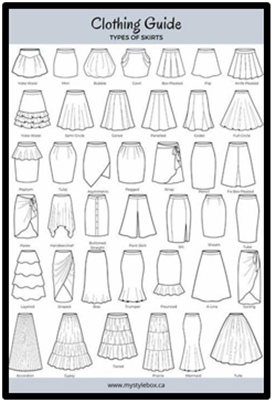
|
Figure 5 Types
of Skirts. Clothing Guide [Photograph]. Www.Stylebox.ca. https://www.pinterest.ca/pin/clothing-guide-types-of-skirts--969610994748170811/ |
1) Catalogue
Planning for Fashion Consumers: Brands can lay a plan of catalog
preparation with adaptations of accompaniments from skirt styles. The fashion
consumers will have a scope for selection as per the suitability and the
occasion. Figure 6 & Figure 7 represent innovations
for fashion accompaniments segregated for Day wear and Evening wear.
Figure 6
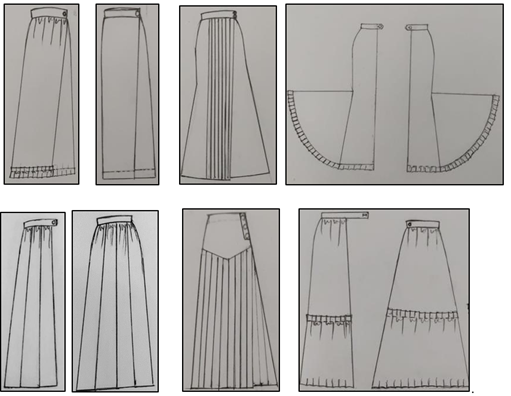
|
Figure 6 6a-6g: Day Wear
Fashion Accompaniments: Conventional, Stylish, Elegant Detachable Skirts. Figure 6a,6b,6c, 6d are Quite Classy and Conventional. Figure 6e,6f,6g are Trendy, Stylish, and Elegant to be Accompanied for Casual to Formal Wear. |
Figure 7
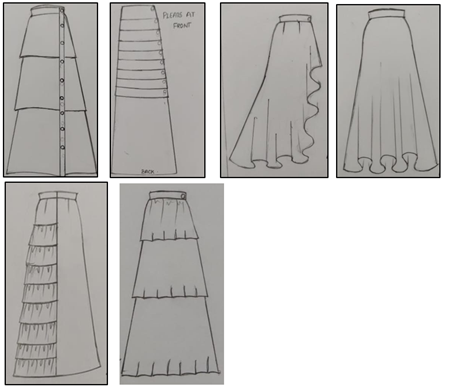
|
Figure 7 7a-7e Represents Detachable Evening Wear Fashion Accompaniments for a Glamorous Look. Figure 7a,7b,7c,7d &7e are Considered as Outstanding for Evening Wear. |
Figure 7a is a layered bias-shaped detachable skirt, 7b has dramatic pleats in front buttoned with snap fasteners which could be lowered down or reduced in length with adjustable pleats and snap fasteners. Figure 7c,7d,7e are detachable accompaniments including voluminous fabric which are quite appealing for bridal and red carpet wear.
2) Classy
and trendy foundation garments for wardrobe: Based on survey analysis and
with the ongoing fashion trend designers can set the trendy and classy
silhouettes to be set as foundation pieces of clothing to be accompanied by
detachable accompaniments to create stylish looks appropriate for the wearer. Figure 8 represents foundation
silhouettes chosen to mix and match with detachable clothing for day wear and
evening wear as per suitability to figure type and occasion.
Figure 8
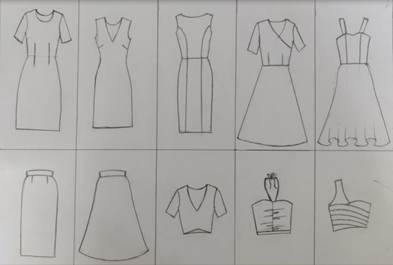
|
Figure 8 Classic and Trendy Silhouettes for Foundation Garments |
3) Experimentation
has been worked in three different ways:
·
Analysis on dress form: Ideas implemented
through initial sketches posed on dress form to analyze
the look and experimented with the practical production process and style the
looks in different ways with the actual garment.
Figure 9
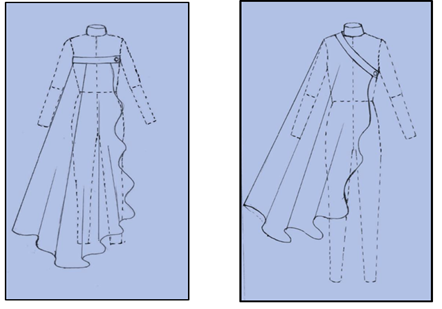
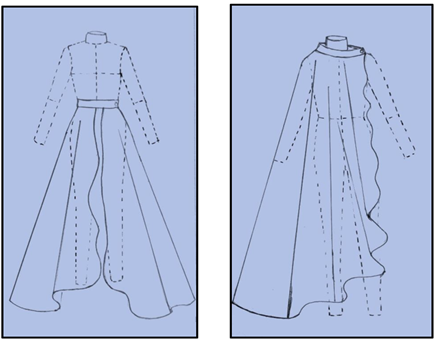
|
Figure 9 9a-9d Represent a High Low Circular Skirt Along with a Waist Belt. The Styling of a Single Piece of Clothing Adorned in Multiple Ways. Style 1 is Adorned at the Bust, Style 2 has a Surplice Design, Style 3 is Adorned at the Waist as a Detachable Skirt, and Style 4 is Ascertained as a Cape Adorned Asymmetrically Around the Neck. |
Production process: Pattern making and sampling
were done for circular high-low detachable accompaniment for Figure 9 in organza fabric to
establish its use and analyze the styles from a
single piece of clothing. Pattern-making process of the skirts is found to be
easy and less time-consuming for production.
Drafting of high-low circular skirt:
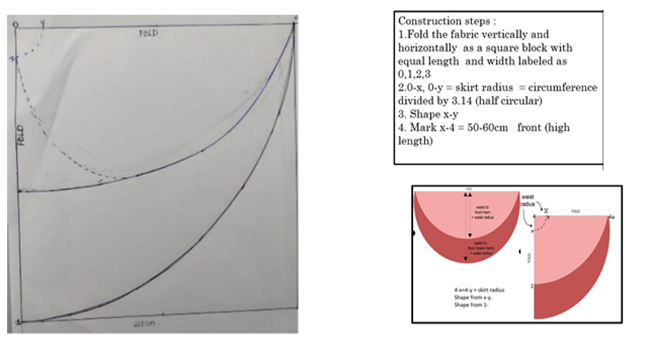
|
Drafting 1 High-Low Detachable
Skirt |
The drafting and
sewing process consumed approximately 20 minutes, and fabric consumption was 2
meters of organza with a fabric width of 44” and was comfortable to work for a
semi-circular skirt. The sewing process was undertaken on a Single needle lock
stitch Juki machine. It was quite cost effective regarding the process of
production and the reuse of leftover fabrics made it more economical.
Figure 10
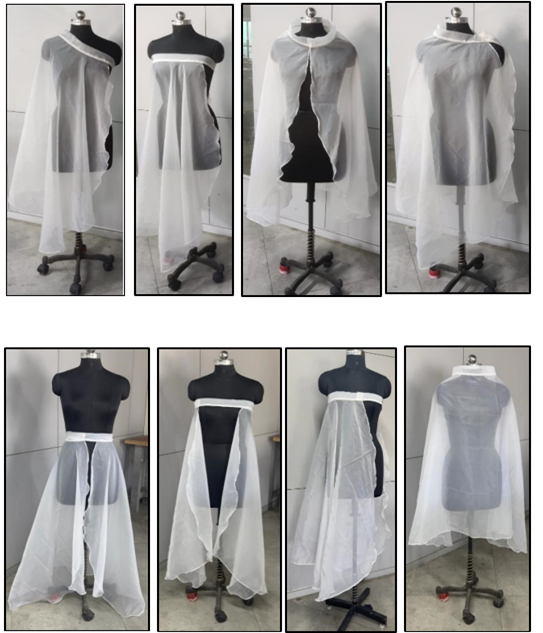
|
Figure 10a-10h **Self-Worked Samples of Circular High-Low Fashion Coordinates Styled in Eight Different Ways on the Dress Form no. 8. Figure 10a- 10h are the Resultant Design Styles of the Sample and are
Adorned in More Than the Illustrated Ways of Styling in Figure 9a-9d. |
Figure 10a represents wrap over or surplice style, 10b represents a
detachable skirt worn over the bust tied at the back, 10c represents the skirt
adorned as a cape at the neck with an opening at the center
front, 10d represents a skirt styled as cape at neck left side as Asymmetric
style, 10e represents worn as detachable skirt with an opening at center front, 10f
cape at bust with covering at back and front till sides, 10g shows Asymmetrical at bust fastened at center front, Figure 10h represents cape with
front covered and back opening.
Snap fasteners were
attested at regular intervals with balls and sockets for easy fastening. The
fastening flexibility gave the option to plan different placements and styles
to create additional looks for the wearer.
·
Analysis of style adaptation in coordination
with foundation silhouette from wardrobe: A trendy silhouette from Figure 6 has been paired with
the detachable article 6c for style experimentation. Figure 11a-11d shows a gathered skirt
styled in four different ways. Style 11a represents the article adorned at the
waist, and Style 11b is visualized with asymmetrical placement at the shoulder,
and neck fastened at the waist. Style 11c visualized the style at the upper
bust. Style 11d visualizes the asymmetrical look with placement at the right side shoulder arm with fastening at the left side seam
below the armhole.
Figure 11
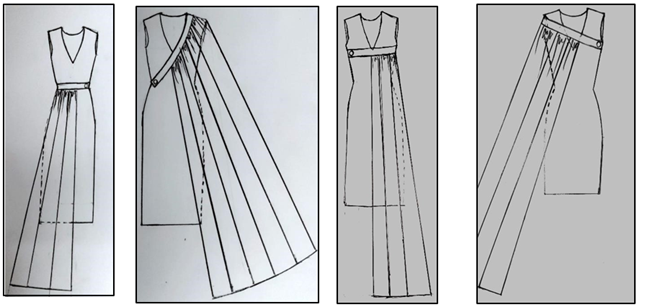
|
Figure 11 11a-11d Illustrates the Multipurpose Utility of a Detachable Garment with Stylish Gathered Accompaniment. |
·
Virtual presentation and visualization using Clo
3d Software: The advancement of technology has been proposed for the
visualization of design styles with 3d software for further design
experimentation.
Fabric compatibility with detailing technique and silhouette variation for visualization of a look with the use of Clo 3d software
Figure 12
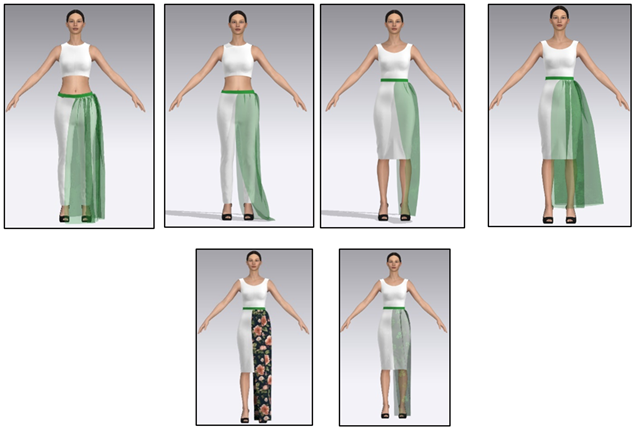
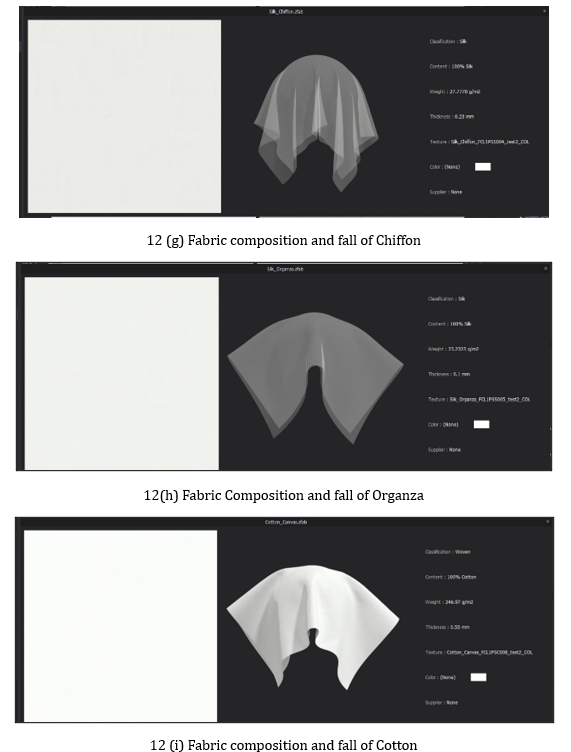
|
Figure 12 12a-12f Have Been Visualized on Clo 7 3d Software with the Fabric Composition as Shared in Figure 12g-12i Along With it. |
Figure 12a & 12b analyze the styles with two different fabrics chiffon &
organza for suitability of gathering detail with a detachable skirt. Figure 12c &12d analyze the style with two different foundation silhouettes
to check the suitability and look of the wearer. Chiffon fabric is more
appealing for gathering details applied in a detachable skirt. Organza fabric
is less apt for gathers due to its fabric properties. In real application, organza is more suitable
for circular styles.
Clo 3d interprets real applications with the fabric and analyzes suitability with fabrics &detailing
techniques. During the process chiffon
band thickness had to be increased. It is evident that organza fabric shows
less suitability for gathering detail. Chiffon looks more appealing for
gathering technique in comparison to organza fabric.
Figure 12e Analyses the style effect of printed cotton fabric and Figure 12f represents printed chiffon look. Printed cotton visualizes an
opaque look as per fabric thickness and is ideal for day wear. Chiffon and
organza have a set of transparency making it more appealing for evening wear.
The virtual presentation assisted in adapting detailing
techniques as per suitability and gave additional options to visualize prints
in less time and modify the look as per eye appeal. It offers further
possibilities, especially in developing virtual try-on technologies. The
continued research helped in the comparison between virtual and real scanned
clothing.
4) Fashion
Detachable Design Collection for young consumers: The design perspective of
this study was enriched with a mini collection of fashion accompaniments along
with the students at Hamstech College of Creative
Education in Hyderabad. Styles were beautifully crafted with garment
construction decorative details like Gathers, Pleats, Ruffles
&Texture. Fabrics leftover from
design houses were procured for the collection and were worked with minimal
consumption and turned out to be the most economical and appealing for young
consumers.
·
Style 1 Figure 13a &13b show a detachable
layered short skirt made of stiff net with emphasis at the back paired with a
top & basic skirt. Fabric
consumption was 5 metres and looked glamorous for party wear.
Figure 13
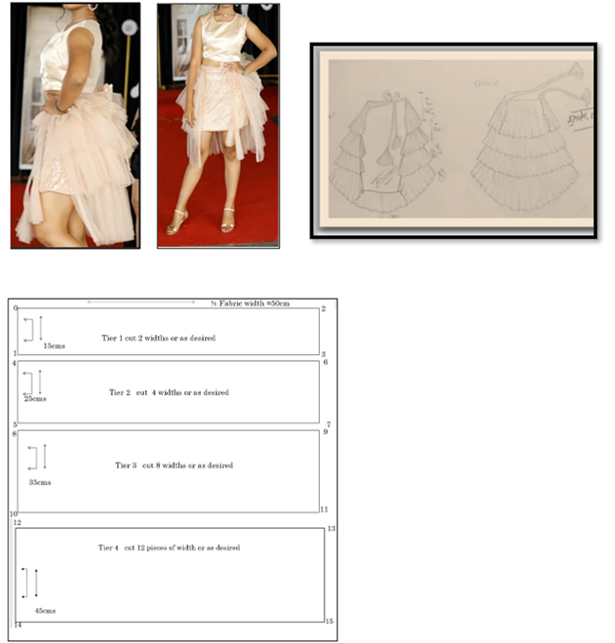
|
Figure 13 is the Front & Back View of the Detachable Layered (Short) Skirt. Drafting no.2 Represents a Drawing of Figure 13a &13b |
Figure 14
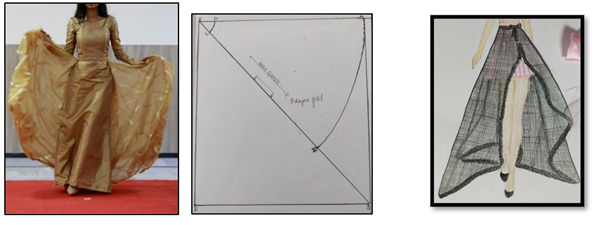
|
Figure 14 |
Figure 15

|
Figure 15 |
·
Style 2 Figure 14 represents a circular
skirt made of silk fabric with a consumption of 4 meters and was adorned along
with a One-piece dress. It looked ideal for Evening wear. Color
gradation embraced silhouette elegance. Drafting 3 represents drawing of Figure 14.
·
Style 3 Figure 15 showcases a wrap skirt
with a graduated flare and single-edge ruffle at the hemline. Printed organza
fabric of 3.5 meters was consumed for its preparation. Drafting 4 represents the drawing of Figure 15.
Figure 16
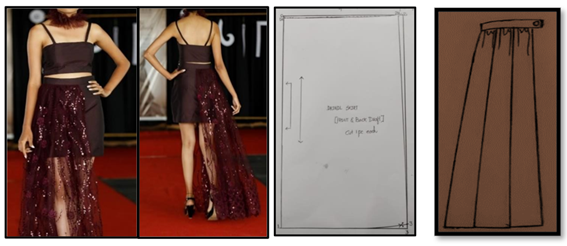
|
Figure 16 |
·
Style 4 Figure 16a, 16 looked glamorous as the textured fabric enhanced the look
of the detachable skirt. The gathered skirt was prepared with 2.5 metres of
fabric as it covered partially and was paired with a top and skirt as an ideal
combination for Evening wear.
Figure 17

|
Figure 17 |
·
Style 5 Figure 17 had a layered panel
made of a stiff net with a fabric consumption of 4 mtrs
paired with a top and a balloon skirt. Drafting 6 represents a drawing of Figure 17.
Figure 18
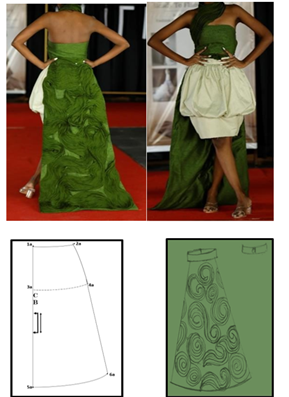
|
Figure 18 |
Figure 13 -Figure 18 were worked along with
the students of Hamstech College of Creative
Education for experimentation with varied design styles.
·
Style 6 Figure 18 was designed
exclusively at the back with a texture made of organza fabric and boning.
Texture was hand-sewn on the skirt panel. Texture preparation consumed 6 meters
of fabric and 1.25 meters of raw silk for the skirt panel. Figure 18 had a wedge panel as a
pattern and texture to enhance the look.
Innovation with textures was the focal for endless possibilities in designing. The complete collection production duration was noted as 14 hours. Time consumption was taken as an average of 1.5 hr for the majority of styles. Layered skirts took 3hrs and textured skirts took 4 hrs to prepare. A simplified pattern-making process was adapted for the accompaniments.
4. RESULT and DISCUSSION
The transformation of clothing has been simplified,
integrating conventional styling into garments. Young designers learned to
incorporate these versatile coordinates into their design processes, showcasing
a collection. Design education can
incorporate real-time applications and enhance the skills to the core.
·
Brands can enhance fashion collections by
incorporating trendy basic silhouettes as classic pieces and include innovative
detachable, made utilizing leftover fabrics from high-fashion garments. A
sample catalog was shared for the execution.
·
The effectiveness of a single piece of clothing
with multi-utility options. These garments can accommodate various sizes,
overcome size limitations, and feature practical and flexible fastening
procedures, making them convenient for most people.
·
Design elements, decorative details, and trendy
fabrics can enhance design prospects, achieving an ideal look for the wearer
based on the category of wear.
·
The Pattern-making process was found to be quite
simple and easy to adapt for different styles and can be incorporated easily
due to minimal time taken in the production and being cost-effective. This
approach allows a single piece to be styled in multiple ways, reducing the need
for new purchases and minimizing waste. They can be interchanged between people
and could be paired with different sets of garments.
·
Catalogues and virtual presentations are
recommended for fashion companies to simplify the selection process as
suitability to the individual figure type. Clo 3d is proposed as an ideal
software for virtual presentation. It can help to mix and match with different
silhouettes and suitability to the wearer. Multi utility clothing has to be initiated to young buyers which is versatile and
promotes sustainability.
It concludes that basic silhouettes can be retained as foundation garments and versatile overlays can be redesigned from the luxury wear skirts and dupattas. The additional pieces of clothing from Figure 5 can enable the wearers to use them in various styles for different occasions in multiple ways as per their choice. The concept is ideal for Sustainable fashion and promotes the long-lasting use of resources reducing the adverse effects on the economy.
5. CONCLUSION
·
Experimentation done on this concept gave
profound results. Design perspective in illustrations had limited ideas in
imagination, but real applications gave endless possibilities of innovation for
styling and visualizing garments.
·
The reusability of existing textiles from
wardrobes like leftover dupattas, skirts, and sarees are more effective in this
adaptation for fashion detachable. Flared skirts, circular skirts, layered,
tiered, and Gathered skirts with the same features can be modified to convert
them as detachable accompaniments to be paired in different styles.
·
Reconceptualization is to style a fashion
co-ordinate as the detachable cape, or a
over-garment. This phenomenon of innovation can be further experimented by
coordinating styles with other separates like tops, pants, and dresses.
· Recommend designers and brands to use CLO 3D effectively to analyze the suitability of detachable clothing along with the existing wardrobe. Virtual displays analyze the suitability to figure type, fabric, and overall look of the wearer. It can map a realistic presentation of the garment to show how detachables would look along with the different silhouettes, fabrics, and figure types.
CONFLICT OF INTERESTS
None.
ACKNOWLEDGMENTS
1) The design ideas for experimentation of the multi-purpose utility of clothing [Figure 9] & Garment Sample [Figure 10] showcased is the outcome of Self-conducted experimentation for the adaptation of fashion accompaniments at the Mody University pattern-making lab.
2) Design collection of six styles [Figure 13 -Figure 18] was showcased with the support of undergraduate students of Hamstech College of Creative Education, Hyderabad.
3) Draftings of Design styles were self-worked with accurate evaluations.
REFERENCES
Aakko, M., & Sivonen, R. K. (2013). Designing Sustainable Fashion: Possibilities and Challenges. Research Journal of Textile and Apparel, 17(1), 13-22. https://doi.org/DOI:10.1108/RJTA-17-01-2013-B002
Azman, S. M. B. S., Arsat, M. B., & Suhairom, N. B. (2019). Integrating Innovation in Pattern Making Teaching and Learning for Higher Education in Fashion Design. Innovative Teaching and Learning Journal, 3 (1), 70-77.
Cao, H., Chang, R., Kallal, J., Manalo, G., McCord, J., Shaw, J., & Starner, H. (2014). "Adaptable Apparel: A Sustainable Design Solution for Excess Apparel Consumption Problem", Journal of Fashion Marketing and Management, 18(1), 52-69. https://doi.org/10.1108/JFMM-08-2012-0046
G, R. (2022). Different Types of Silhouettes in Fashion Design September 14, 2022, By Robert G.
Gupta, D. (2020). New Directions in the Field of Anthropometry, Sizing and Clothing Fit (1st ed., 3-27). Wood Head Publishing The Textile Institute Book Series 2020. https://doi.org/10.1016/B978-0-08-102604-5.00001-9
Hasan, M. M. (2021, June 20). Transformable Fashion. Fashion https://textiledetails.com
Islam Kiron, M. (2021, July 4). What is Silhouette in Fashion | Types of Silhouettes. Textile learner.
Koo, H. S., Dunne, L., & Bye, E. (2013). Design Functions in Transformable Garments for Sustainability. International Journal of Fashion Design, Technology and Education, 7(1), 10-20. https://doi.org/10.1080/17543266.2013.845250
Lagė, A., & Ancutienė, K. (2019). "Virtual Try-On Technologies in the Clothing Industry: Basic Block Pattern Modification". International Journal of Clothing Science and Technology, 31(6), 729-740. https://doi.org/10.1108/IJCST-11-2018-0140
Mellander, E., & McIntyre, M. P. (2021). Fashionable Detachments: Wardrobes, Bodies and the Desire to Let go. Routledge, Informa UK Limited, Trading as Taylor & Francis Group, 24(4), 343-356. https://doi.org/10.1080/10253866.2020.1802258
Quillan, H. M. (2020). Digital 3D Design as a Tool for Augmenting Zero-Waste Fashion Design Practice. International Journal of Fashion Design, Technology and Education, 13(1). https://doi.org/10.1080/17543266.2020.1737248
Rajput, D. N., & Khanna, A. (2014). Dynamics of Young Indian Consumers' Buying Behaviour Towards Branded Apparels: Gender Perspective. Archives of Business Research. https://doi.org/DOI:10.14738/abr.25.596
Rehman, O., & Kharb, D. (2018). Fashion Innovativeness in India: Shopping Behavior, Clothing Evaluation, and Fashion Information Sources. International Journal of Fashion Design, Technology and Education, 11(3), 287-298. https://doi.org/10.1080/17543266.2018.1429498
Yan, J., & Kuzmichev, V. E. (2020). A Virtual E-Bespoke Men's Shirt Based on New Body Measurements and Method of Pattern Drafting. Textile Research Journal 0(00) 1-22. https://doi.org/10.1177/0040517520913347
Zhang, X., Normand, A. L., Yan , S., Wood, J., & Henninge, C. (2024). What is Modular Fashion: Towards A Common Definition. Elsevier -Resources, Conservation, Recycling, 204. https://doi.org/10.1016/j.resconrec.2024.107495
|
|
 This work is licensed under a: Creative Commons Attribution 4.0 International License
This work is licensed under a: Creative Commons Attribution 4.0 International License
© ShodhKosh 2024. All Rights Reserved.

